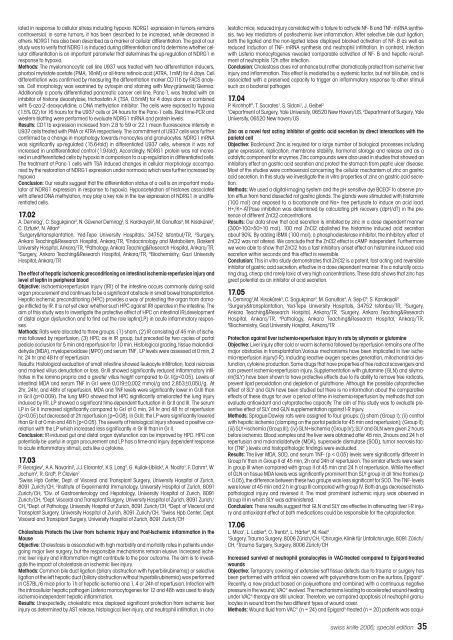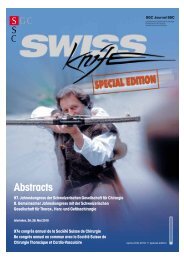Abstracts 4. Gemeinsamer Jahreskongress der ... - SWISS KNIFE
Abstracts 4. Gemeinsamer Jahreskongress der ... - SWISS KNIFE
Abstracts 4. Gemeinsamer Jahreskongress der ... - SWISS KNIFE
You also want an ePaper? Increase the reach of your titles
YUMPU automatically turns print PDFs into web optimized ePapers that Google loves.
swissknife spezial 06 12.06.2006 13:39 Uhr Seite 35<br />
lated in response to cellular stress including hypoxia. NDRG1 expression in tumors remains<br />
controversial, in some tumors, it has been described to be increased, while decreased in<br />
others. NDRG1 has also been described as a marker of cellular differentiation. The goal of our<br />
study was to verify that NDRG1 is induced during differentiation and to determine whether cellular<br />
differentiation is an important parameter that determines the up-regulation of NDRG1 in<br />
response to hypoxia.<br />
Methods: The myelomonocytic cell line U937 was treated with two differentiation inducers,<br />
phorbol myristate acetate (PMA, 16nM) or all-trans retinoic acid (ATRA, 1mM) for 4 days. Cell<br />
differentiation was confirmed by measuring the differentiation marker CD11b by FACS analysis.<br />
Cell morphology was examined by cytospin and staining with May-grünwald/Giemsa.<br />
Additionally a poorly differentiated pancreatic cancer cell line, Panc-1, was treated with an<br />
inhibitor of histone deacetylase, trichostatin A (TSA, 0.5mM) for 4 days alone or combined<br />
with 5-aza-2’-deoxycytidine, a DNA methylation inhibitor. The cells were exposed to hypoxia<br />
(1.5% 02) for 16 hours for the U937 cells or 24 hours for the Panc-1 cells. Real time-PCR and<br />
western-blotting were performed to evaluate NDRG1 mRNA and protein levels.<br />
Results: CD11b expression increased from 2.8 to 59 or 22.1 mean fluorescence intensity in<br />
U937 cells treated with PMA or ATRA respectively. The commitment of U937 cells was further<br />
confirmed by a change in morphology towards monocytes and granulocytes. NDRG1 mRNA<br />
was significantly up-regulated (15.6-fold) in differentiated U937 cells, whereas it was not<br />
increased in undifferentiated control (1.9-fold). Accordingly, NDRG1 protein was not increased<br />
in undifferentiated cells by hypoxia in comparison to a up-regulation in differentiated cells.<br />
The treatment of Panc-1 cells with TSA induced changes in cellular morphology accompanied<br />
by the restoration of NDRG1 expression un<strong>der</strong> normoxia which was further increased by<br />
hypoxia<br />
Conclusion: Our results suggest that the differentiation status of a cell is an important modulator<br />
of NDRG1 expression in response to hypoxia. Hypoacetylation of histones associated<br />
with altered DNA methylation, may play a key role in the low expression of NDRG1 in undifferentiated<br />
cells.<br />
17.02<br />
A. Demirag 1 , C. Sogukpinar 2 , N. Güvener Demirag 3 , S. Karakayali 2 , M. Gonultas 4 , M. Kisakürek 5 ,<br />
C. Ozturk 6 , N. Altan 6<br />
1 Surgery&transplantation, Yed-Tepe University Hospitals, 34752 Istanbul/TR, 2 Surgery,<br />
Ankara Teaching&Research Hospital, Ankara/TR, 3 Endocrinology and Metabolism, Baskent<br />
University Hospital, Ankara/TR, 4 Pathology, Ankara Teaching&Research Hospital, Ankara/TR,<br />
5 Surgery, Ankara Teaching&Research Hospital, Ankara/TR, 6 Biochemistry, Gazi University<br />
Hospital, Ankara/TR<br />
The effect of hepatic ischaemic preconditioning on intestinal ischemia-reperfusion injury and<br />
level of leptin in peripheral blood<br />
Objective: Ischaemia-reperfusion injury (IRI) of the intestine occurs commonly during solid<br />
organ procurement and continues to be a significant obstacle in small bowel transplantation.<br />
Hepatic ischemic preconditioning (HPC) provides a way of protecting the organ from damage<br />
inflicted by IR. It is not yet clear whether such HPC against IRI operates in the intestine. The<br />
aim of this study was to investigate the protective effect of HPC on intestinal IRI,development<br />
of distal organ dysfunction and to find out the role leptin(LP) in acute inflammatory responses.<br />
Methods: Rats were allocated to three groups: (1) sham, (2) IR consisting of 45 min of ischemia<br />
followed by reperfusion, (3) HPC, as in IR group, but preceded by two cycles of portal<br />
pedicle occlusion for 5 min and reperfusion for 10 min. Histological grading, tissue malondialdehyde<br />
(MDA), myeloperoxidase (MPO) and serum TNF , LP levels were assessed at 0 min, 2<br />
hr, 24 hr and 48 hr of reperfusion.<br />
Results: Histological evaluation of small intestine showed leukocyte infiltration, focal necrosis<br />
and marked villus denudation or loss. Gr.III showed significantly reduced inflammatory infiltrates<br />
in the lamina propria and a greater villus height compared to Gr. II(p10 mol). 100 mol ZnCl2 abolished the histamine induced acid secretion<br />
about 90%. By adding IBMX (100 mol), a phosphodiesterase inhibitor, the inhibitory effect of<br />
ZnCl2 was not altered. We conclude that the ZnCl2 effect is cAMP independent. Furthermore<br />
we were able to show that ZnCl2 has a fast inhibitory onset effect on histamine induced acid<br />
secretion within seconds and this effect is reversible.<br />
Conclusion: This in vitro study demonstrates that ZnCl2 is a potent, fast acting and reversible<br />
inhibitor of gastric acid secretion, effective in a dose dependent manner. It is a naturally occuring<br />
drug, cheap and rarely toxic at very high concentrations. These data shows that zinc has<br />
great potential as an inhibitor of acid secretion.<br />
17.05<br />
A. Demirag 1 ,M. Kisakürek 3 , C. Sogukpinar 3 , M. Gonultas 4 , A. Sep-C 5 , S. Karakayali 3<br />
1 Surgery&transplantation, Yed-Tepe University Hospitals, 34752 Istanbul/TR, 2 Surgery,<br />
Ankara Teaching&Research Hospital, Ankara/TR, 3 Surgery, Ankara Teaching&Research<br />
Hospital, Ankara/TR, 4 Pathology, Ankara Teaching&Research Hospital, Ankara/TR,<br />
5 Biochemistry, Gazi University Hospital, Ankara/TR<br />
Protection against liver ischemia-reperfusion injury in rats by silymarin or glutamine<br />
Objective: Liver injury after cold or warm ischemia followed by reperfusion remains one of the<br />
major obstacles in transplantation.Various mechanisms have been implicated in liver ischemia-reperfusion<br />
injury(I-R), including reactive oxygen species generation, mitochondrial dysfunction,<br />
cytokine production. Some drugs that have properties of free radical scavengers and<br />
can prevent ischemia-reperfusion injury. Supplementation with glutamine (GLN) and silymarin(SLY)<br />
have been shown to have protective effects due to its ability to remove free radicals,<br />
prevent lipid peroxidation and depletion of glutathione. Although the possible cytoprotective<br />
effect of SLY and GLN have been studied but there is no information about the comparative<br />
effects of these drugs for over a period of time in ischemia-reperfusion by methods that can<br />
evaluate antioxidant and cytoprotective capacity. The aim of this study was to evaluate preventive<br />
effect of SLY and GLN supplementation against I-R injury.<br />
Methods: Sprague-Dawley rats were assigned to four groups: (i) sham (Group I); (ii) control<br />
with hepatic ischemia (clamping on the portal pedicle for 45 min and reperfusion); (Group II);<br />
(iii) SLY+ischemia (Group III); (iv) GLN+ischemia (Group IV); SLY and GLN were given 2 hours<br />
before ischemia. Blood samples and the liver were obtained after 45 min, 2hours and 24 h of<br />
reperfusion and malondialdehyde (MDA), superoxide dismutase (SOD), tumor necrosis factor<br />
(TNF ) levels and histopathologic findings were evaluated.<br />
Results: The liver MDA, SOD, and serum TNF- (p < 0.05) levels were significantly different in<br />
Group IV than in Group II at 45 min, 2h and 24h of reperfusion. The similar effects were seen<br />
in group III when compared with group II at 45 min and 24 h of reperfusion. While the effect<br />
of GLN on tissue MDA levels was significantly prominent than SLY group in all time frames (p<br />
< 0.05), the difference between these two groups was less significant for SOD. The TNF- levels<br />
were lower at 45 min and 2 h in group III compared with group IV. Both drugs decreased histopathological<br />
injury and reversed it. The most prominent ischemic injury was observed in<br />
Group III in which SLY was administered.<br />
Conclusion: These results suggest that GLN and SLY are effective in attenuating liver I-R injury<br />
and antioxidant effect of both medications could be responsible for the cytoprotection.<br />
17.06<br />
L. Mica 1 , L. Labler 2 , O. Trentz 2 , L. Härter 3 , M. Keel 2<br />
1 Surgery, Trauma Surgery, 8006 Zürich/CH, 2 Chirurgie, Klinik für Unfallchirurgie, 8091 Zürich/<br />
CH, 3 Trauma Surgery, Surgery, 8006 Zürich/CH<br />
Increased survival of neutrophil granulocytes in VAC-treated compared to Epigard-treated<br />
wounds<br />
Objective: Temporary covering of extensive soft tissue defects due to trauma or surgery has<br />
been performed with artificial skin covered with polyurethane foam on the surface, Epigard ® .<br />
Recently, a new product based on polyurethane and combined with a continuous negative<br />
pressure in the wound, VAC ® evolved. The mechanisms leading to accelerated wound-healing<br />
un<strong>der</strong> VAC ® -therapy are still unclear. Therefore, we compared apoptosis of neutrophil granulocytes<br />
in wound from the two different types of wound cover.<br />
Methods: Wound fluid from VAC ® (n = 24) and Epigard ® -treated (n = 20) patients was acqui-<br />
swiss knife 2006; special edition 35
















